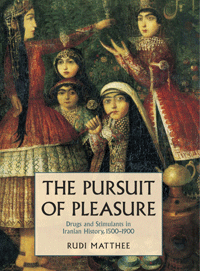 That modernization stuff That modernization stuff
Part 2: Returning to Iran: 1986-87
>>>Images
Sima Nahan
March 6, 2006
iranian.com
As to living in the west, where is one to search for the source of this new sense of alienation? That the popular media thrive on foreign objects of fear and hatred should hardly be surprising and certainly not intellectually unsettling any more. That one religion, nation, or "race" should replace another in the popular imagination as enemy surely must not become more troubling because one happens to belong to it? Or, at least, one should like to think that the images generated by the machinery of mass media are ultimately too fickle to withstand any real scrutiny.
The shortsight, the obscured point of contention, must be working its effect in a more unexpected way, managing to extend across borders a predisposi–tion toward silence that has long been necessitated for Iranians by the internal conditions of the country. Censorship and fear of persecution are by now solidly ingrained in the fabric of Iranian life inside the country. But other, subtler factors muffle its voice outside Iran. These can be pointed out, for instance, in the ap–parently benign objectivity of the title of "Islamic" for the 1979 revolution in Iran -- the catchword outcome of a rare (and ill-boding) collaboration between the news media and American academia.
I write from the vantage point of a national consciousness all too familiar with how things are not what they appear to be, and with how one's best efforts are likely to work to one's detriment. These are points at which almost the entire spectrum of political ideologies in Iran seems to converge. One could even claim that this realiza–tion is the common ground between the most opposed contenders of political righteousness and power in Iran: from political prisoners and exiles of all persuasions, to the hundreds of thousands of martyrs and veterans of war whose sacrifice was ultimately to be washed down with a dose of metaphoric "poison," even to the Shah himself who could have, really, in the interest of buying himself a little more time shed a lot more blood before succumbing to his downfall.
Furthermore, I write from the vantage point of that nameless segment of Iranian society that could roughly be described as descendants of the "liberation," azadikhahi, movement that brought about the 1906 constitutional revolution. Drawn from all walks of Iranian life -- from bazaars and mosques to western-educated intel–lectuals and even progressive aristocracy -- this was a community united within itself and with its contemporary incarnation in its demand for national sovereignty, equity, and something to the effect of democracy. It was the enduring legacy of this movement, a vague and ill-defined idealism -- as vague and ill-defined as any genuine and uncorrupted idealism by nature is -- that never looked kindly upon the Pahlavi dynasty. This was undoubtedly at work when on a number of critical occasions the Shah looked to the country's increasingly prosperous middle class to find very little sup–port.
 To narrow down my particular standpoint even further, I might trace my lineage through the "westernized" intelligentsia of Iran -- that, in turn, part of the "modernized" Iranians who were most severely outcast by the Islamic Republic. But I won't talk here about the political defeat of the Iranian intelligentsia. They have long since made the bitter admission, and the complex history of it is quietly being penned and stored underground until the time comes for its surfacing. The notion which by virtue of being simplistic is more readily taken up is the idea of the "cultural" defeat of the Iranian intellectual community -- a point on which both the Islamic Republic and a good deal of latter-day Orientalist scholarship insist. To narrow down my particular standpoint even further, I might trace my lineage through the "westernized" intelligentsia of Iran -- that, in turn, part of the "modernized" Iranians who were most severely outcast by the Islamic Republic. But I won't talk here about the political defeat of the Iranian intelligentsia. They have long since made the bitter admission, and the complex history of it is quietly being penned and stored underground until the time comes for its surfacing. The notion which by virtue of being simplistic is more readily taken up is the idea of the "cultural" defeat of the Iranian intellectual community -- a point on which both the Islamic Republic and a good deal of latter-day Orientalist scholarship insist.
In Tehran, it is said that the main difference between the Iranian revolution and the French revolution is that in France the lumpen made the revolution and the intellectuals led it, while in Iran the intellectuals made the revolution and the lumpen lead.
Back in 1789, however, there was no talk of the "modernized" intellectuals vs. the "traditional" sans-culottes ("populace," "proletariat," what have you). It was presumed then, as it is presumed now, that they all spoke French and citizenship was a human right. But in the case of Iran, "experts" point to the cultural failure of the intel–ligentsia, which by virtue of its more or less secular tradition as well as its exposure to the west, is presumed necessarily "western."
The long-standing participation of intellectuals, students, writers, artists, technocrats, and other segments of the population uncharac–teristic of the "traditional masses" in the events that led to the 1979 revolution as well as the street confrontations which came to represent it, notwithstanding, we are suddenly to accept that it is not its political power that has put the Hezbollah in position of leadership over us but the power of its traditional/religious iden–tity. What comprises the political power base of the present ruling elite in Iran is one matter, and whose creation the myth of "modern–ization" is, another.
In a surprisingly anti-historical vein it has become the vogue to set the revolution in Iran apart from other social revolutions in the world. It is seen not as demand for progress but as a reaction against it. In as much as progress has come to be measured in terms of those amenities of modern life that are offered by technology, and by those aspects of western civilization that are primarily transmitted through its facilitation, the verdict is quick to follow that "the Shah modernized too fast." By extension, we, the "modern–ized" Iranians, are seen as cultural mutants, byproducts of some newfangled cultural policies of the Shah and his father.
But the question is this: Is it possible for the modern (i.e. "western") world, bypassing its most logical link with the persistently "pre-modern" (i.e. "non-western") world to go directly to the heart of the fundamentalist masses and perceive us as aliens in our own culture? Or is it that owing to our multilingual education we have shed our veneer of "otherness," thus are seen as even less capable of representing our, after all, living culture, now, than when we were "exotic"?
Or perhaps, one begins to suspect, quite out of the control of the Shah of Shahs, Modern Man ought to be credited with the creation of Modernized Man -- after his own image, as creation goes. The result of this is that we, the "modernized" ones, have lost an identity as Other, gained one as Image, and dismissed in the conviction that we are mere ambivalent reflections of the real thing -- oriental or occidental. The upshot is that not just Iranian but third-world intelligentsia in general are cast aside by their peers in the west. Our western counterparts think of us as just watered-down images of themselves. They are not really interested in us. They want to hear from the "real" people. In Africa, for example, "real" people are helpless and malnourished and in the Middle East they are fundamentalist and violent who know nothing about the west but hate it nonetheless.
 But, "modernized" Iranians, it is safe to say, would have to be foolhardy at this point to insist on revolutionary strategies, on some notion of a radical new beginning. We can no longer afford to expect a new truth and a new identity to emerge from the rubble of ravaged images and idols -- that sort of vision has already secured its proper place in the history of Iran and Islam. Considerations of feasibili–ty and human cost inhibit the urge to start from scratch. Or, to put it differently, insofar as we have inherited a text, a history and an "ethnography" that the west has authored on us, it would be ineffectual to resort, as it were, to book-burning. In fact, it is by fully deciphering western testimonials of all types that we can hope to generate a common language in which to write our own. But, "modernized" Iranians, it is safe to say, would have to be foolhardy at this point to insist on revolutionary strategies, on some notion of a radical new beginning. We can no longer afford to expect a new truth and a new identity to emerge from the rubble of ravaged images and idols -- that sort of vision has already secured its proper place in the history of Iran and Islam. Considerations of feasibili–ty and human cost inhibit the urge to start from scratch. Or, to put it differently, insofar as we have inherited a text, a history and an "ethnography" that the west has authored on us, it would be ineffectual to resort, as it were, to book-burning. In fact, it is by fully deciphering western testimonials of all types that we can hope to generate a common language in which to write our own.
It has virtually become a methodological necessity for us to adhere to a decidedly old-school hierarchy of authority. We can expect to begin with the ingestion of a good deal of commentary, and graduate from the stage of annotation and interpretation (or sometimes simply the highlighting) of existing texts before attempting authorship of new ones. Thus engrossed, we may be spotted in the long robes and shaved heads of disciples, lugging about the great books of the masters (oriental and occidental). There is nothing modern or modernized about this. And regardless of our posi–tion in the hierarchy of authorship, the immediate task remains to mediate in the confrontation between consciousnesses that thrive on mutual incomprehensibility >>>Images
Thinking over the writing that has appeared on Iran since the revolution, the exemplification of one particularly bold such confrontation comes to my mind >>> Part 3
[Part (1) (2) (3) (4) (5) (6) (7) (8) (9) (10) (11) (12) (13) (14) (15) (16) (17)]
About
Sima Nahan is a writer based in California. She graduated from Reza Shah Kabir high school in Tehran.
|